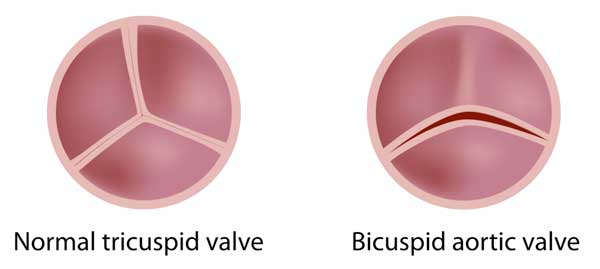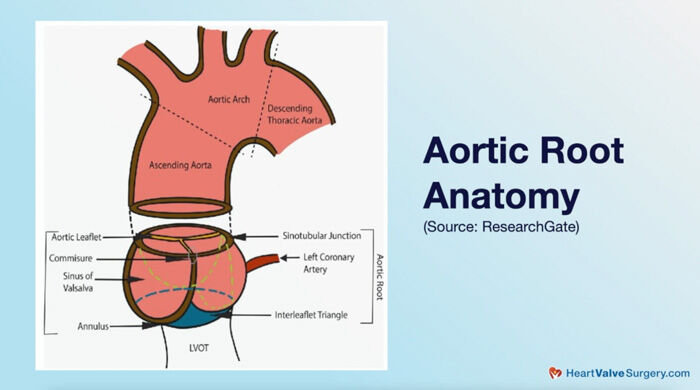Surgeon Q&A: “What About Valve-Sparing Aortic Root Replacement for Bicuspid Aortic Valves?” asks Sandra
Written By: Allison DeMajistre, BSN, RN, CCRN
Medical Expert: Joanna Chikwe, MD, Chair of Cardiac Surgery, Cedar-Sinai Medical Center
Reviewed By: Adam Pick, Patient Advocate, Author & Website Founder
Published: June 6, 2024
A normal aortic valve has three leaflets, or flaps, that open to pump blood out of the heart when it contracts and close tightly when it relaxes. However, nearly two percent of the population have a bicuspid aortic valve with only two leaflets. A bicuspid valve is often asymptomatic early in life and only found by a physician who hears a murmur when listening to the heart or during a test to diagnose another condition.

Although many people live a normal life without the valve causing any problems, nearly 50% will require aortic valve surgery within 25 years of diagnosis, according to the Journal of the American Heart Association. The most common reason for surgery is the formation of an aortic root aneurysm, a stretching out and enlargement where the aorta meets the aortic valve. Once an aneurysm forms, it must be monitored and managed closely because it tends to get larger over time.
Once the aortic root aneurysm reaches 5 to 5.5 centimeters in diameter, surgeons require surgical repair or replacement since there is a risk of the area rupturing, which is a life-threatening situation.

We received a great question about this from Sandra, who is experiencing this exact problem. She asks, “I have a bicuspid aortic valve with aortic regurgitation and aneurysm. I’ve been told I need a replacement, but I’m learning about valve-sparing techniques on your website. Is valve-sparing the same as an aortic valve repair, and what are the outcomes of valve-sparing procedures?”
To answer Sandra’s question, I was thrilled to connect with Dr. Joanna Chikwe in her office at Cedars-Sinai Medical Center in Los Angeles, California. Dr. Chikwe is the Founding Chair of Cardiac Surgery at Cedars-Sinai and a great resource for detailed answers to patient questions. During her extraordinary career, Dr. Chikwe has performed thousands of heart valve operations and has successfully treated many patients in our community.
Key Learnings About Valve-Sparing Aortic Root Replacement
Here are important insights from Dr. Chikwe:
- Many times, the valve leaflets don’t need to be repaired. “That is a great question and one of my favorite operations,” said Dr. Chikwe. “Generally, you don’t have to repair the valve leaflets. Oftentimes, patients have no aortic leak, and we’re replacing or repairing the aneurysm around the valve.
- What are the outcomes of the valve-sparing aortic root replacement procedures? “Phenomenal safety records and great durability,” Dr. Chikwe told us. “Patients should expect to live a decade, two decades without any need for further surgery on the aorta.”
- Is there sometimes a difference in how the valve looks on the echocardiogram versus during surgery that needs to be addressed? “Very rarely,” Dr. Chikwe said. “Usually you’ve got a pretty good idea from the echo if there’s calcium or reduced leaflet mobility that will make it difficult to preserve the valve.” Chikwe said the goal is always to repair the valve, especially if it’s a younger patient with normal leaflets and an aneurysm. “It’s great if we can keep that valve, and that’s a valve-sparing root replacement,” she said.
- Patients often ask about how the aneurysm is fixed and what is done to ensure blood flows with no risk of a dissection or tear. Chikwe said, “The goal is to replace as much of the abnormal aorta as we can with a tube made of Dacron. It’s a polyester that isn’t going to stretch. The more aorta we can replace at one time, the less chance of developing an aneurysm in the future.”
Thanks Dr. Chikwe and Cedars-Sinai Medical Center!
Many thanks to Dr. Joanna Chikwe for everything you and your team at Cedars-Sinai do for HeartValveSurgery.com patients like Sandy and patients all over the world!
Related links:
Keep on tickin,
Adam
Video Transcript
Adam: Hi, everybody. It’s Adam with HeartValveSurgery.com. Today we’re in Los Angeles, and I’m thrilled to be joined by Dr. Joanna Chikwe, who is the founding chair of Cardiac Surgery at Cedar Sinai Medical Center. Dr. Chikwe, it is great to see you again.
Dr. Chikwe: Great to see you, Adam.
Adam: Yeah, it’s wonderful to be here in your office, and we’re going to use this time to answer a patient question, Dr. Chikwe. This one came in from Sandra, and she asks, “Hi, Adam. I have a bicuspid aortic valve with aortic regurgitation and an aneurysm. I’ve been told I need a replacement, but I’m learning about valve-sparing techniques on your website. Is valve-sparing the same thing as an aortic valve repair, and what are the outcomes for valve-sparing procedures?”
Dr. Chikwe: That’s a great question. It’s one of my favorite operations. Generally, you don’t have to repair the valve leaflets. Often times, patients have no aortic leak, and what you’re doing is replacing, repairing the aneurysm around the valve. What are the outcomes? Phenomenal safety records; great durability; patients that should expect to live a decade, two decades without any need for further surgery on their aorta.
Adam: That’s great to learn about those outcomes. I’m curious, Dr. Chikwe. When you’re in the operating room and you actually see a bicuspid aortic valve but you go in thinking I’m just going to fix the aorta issue, do you ever say, wow, this is actually different than what I saw on the echo and now we do have to do something to address the valve?
Dr. Chikwe: I think really rarely. Usually, you’ve got a pretty good idea from the echo before if there’s calcium or reduced leaflet mobility that’s going to make it difficult to preserve that valve, and you always try and repair it. Sometimes you get a result that makes you confident that’s not going to need a replacement. The key thing is, for a younger patient who’s got essentially normal leaflets and an aneurysm, it’s really great if we can keep that valve, and that’s a valve-sparing root replacement.
Adam: The final question people are always curious to know, patients, is how do you fix an aneurysm? What do you do to ensure blood flows and I’m not at risk for a dissection or a tear?
Dr. Chikwe: The goal is to replace as much of the abnormal aorta as we can with a tube that’s made of Dacron. It’s a polyester, and that isn’t going to stretch. The more aorta that we can replace at one time, the less the chances of developing an aneurysm in the future.
Adam: Dr. Chikwe, on behalf of all the patients at HeartValveSurgery.com, patients all over the world, thanks for everything you are doing here at Cedar Sinai in Los Angeles.
Dr. Chikwe: Thank you, Adam.
Adam: Hi, everybody. It’s Adam. I hope you enjoyed that video, and don’t forget, you can always subscribe to our YouTube channel. Watch the next two educational videos coming up on your screen or click the blue button to visit HeartValveSurgery.com.






